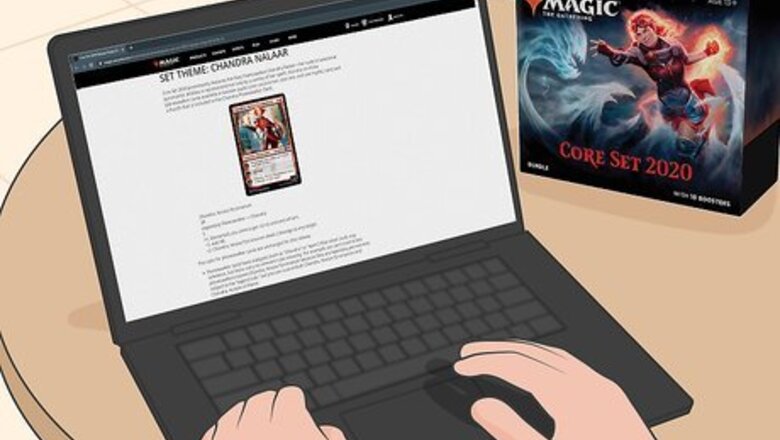
views
X
Research source
Preparing to Select Cards

Review the rules of Magic:The Gathering. In order to build a successful deck, familiarity with the rules of Magic: The Gathering (hereby referred to as “MTG”) is paramount. Knowledge of the phases of a player’s turn, and the playing of “Land” and casting of “Spells” are of particular importance. Also review and understand the concepts of “State-based Effects”, the “Stack” (or queue of “Spells” about to resolve upon casting them), and the different “Zones” involved in the game (ex: “Graveyard”, “Library”, “Battlefield”, etc.). There are several game types that are commonly used in MTG. These include “Modern”, “Standard”, “Legacy”, “Vintage”, “Commander (EDH)”, and others. Each game type allows a different collection of cards to be used.
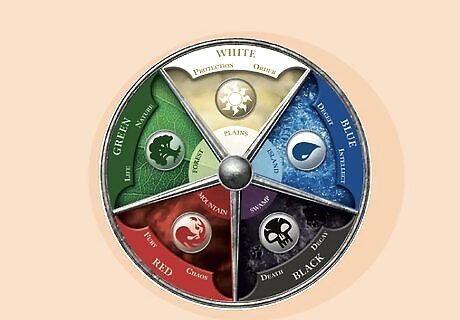
Determine the color you are best in. Play around on sites like MTGDeckBuilder and MTGVault. See what cards you can imagine yourself playing and what style suits the way you think. The color(s) you will use in your MTG deck will determine which “Land” cards that you will put in the deck. You will be able to cast “Colorless” spells (spells that have no colored mana symbols in their “mana cost”) regardless of the color(s) you choose. The more colors you choose for your deck to incorporate, the higher the chance that you will encounter a situation where you will be unable to cast one or more of the spells in your hand due to lacking one (or more) of the colors of mana those spells require in their “mana cost”. Plan accordingly. White's strengths are a roster of small creatures that are strong collectively: protecting those creatures with enchantments, gaining life, preventing damage to creatures or players, imposing restrictions on players, reducing the capabilities of opposing creatures, and powerful spells that "equalize" the playing field by destroying all cards of a given type. White creatures are known for their "protection" from various other colors, or even types of cards rendering them nearly impervious to harm from those things. Numerous white creatures also have "First Strike", "Lifelink", and "Vigilance". White's weaknesses include a focus on creatures, its unwillingness to simply kill creatures outright (instead hobbling them with restrictions that can be undone), and the fact that many of its most powerful spells affect all players equally—including the casting player. Blue is best at letting a player draw additional cards; permanently taking control of an opponent's cards; returning cards to their owner's hand; and countering spells, causing them to be discarded and the Mana used to pay them wasted. Blue's creatures tend to be weaker than creatures of other colors, but commonly have abilities and traits which make them difficult to damage or block, particularly "flying" and to a lesser extent "shroud". Blue's weaknesses include having trouble permanently dealing with spells that have already been played, the reactive nature of most of its spells, and a small (and expensive) roster of creatures. Black is best at destroying creatures, forcing players to discard cards from their hand, making players lose life, and returning creatures from the dead. Furthermore, because Black seeks to win at all costs, it has limited access to many abilities or effects that are normally available only to one of the other colors; but these abilities often require large sacrifices of life totals, creatures, cards in hand, cards in library, and other difficult-to-replace resources. Black is known for having creatures with the ability "Intimidate", making them difficult to block. Lesser black abilities include "Deathtouch" and "Regeneration". Black's main weaknesses are an almost complete inability to deal with enchantments and artifacts, its tendency to hurt itself almost as badly as it hurts the opponent, and difficulties in removing other Black creatures. Red's interests include destroying opposing lands and artifacts, sacrificing permanent resources for temporary but great power, and playing spells that deal "direct damage" to creatures or players, usually via applications of fire. Red has a wide array of creatures, but with the exception of extremely powerful dragons, most are fast and weak, or with low toughness, rendering them easier to destroy. Some of Red's cards can turn against or hurt their owner in return for being more powerful for their cost. Red also shares the trickery theme with Blue and can temporarily steal opponents' creatures or divert spells, although generally not permanently. Many of Red's most famous creatures have the "Haste" trait, which lets them attack and use many abilities earlier. The ability to raise a creature's power temporarily is also common among Red's creatures. Red's weaknesses include its inability to destroy enchantments, the self-destructive nature of many of its spells, and the way in which it trades early-game speed at the cost of late-game staying power. Red also has the vast majority of cards that involve random chance. Green has a large number of creatures, which tend to be the largest in the game for their cost. Many of its spells make them stronger temporarily. It can also destroy "unnatural" artifacts and enchantments, increase a player's life total, get extra lands or other mana sources into play, and produce the other four colors of mana. Green creatures often have "Trample", an ability which lets them deal attack damage to an opponent if blocked by a weaker creature. Green's weaknesses include its difficulty destroying creatures directly; a distinct shortage of flying creatures, and a lack of strategic options other than its signature large creatures.
Building Your Deck Concept and Mana Curve

Determine a “deck concept”. There are five main types of non-land cards in MTG. These are “Creature”, “Sorcery”, “Instant”, “Enchantment” and “Artifact”. While it is possible to build a deck in nearly any combination of these types, the vast majority of MTG decks will have a significant number of “Creature” cards (generally between 30% and 40% of the deck) with which to “Attack” during your “Declare Attackers Phase”, “Block” during your “Declare Blockers Phase”, and to activate the various “Activated Abilities” that many creatures have printed on them. Creatures can also have “Static Abilities” printed on the card that provide a constant effect on the “Battlefield”. One main premise of building a successful MTG deck is to choose cards that will work well or elevate the abilities of one another. Choosing what type of recurrent themes to feature in your deck is central to this process and will comprise your “deck concept”. An example of a “deck concept” would be to include a large number of “Creature” cards in your deck with the “Creature Type” of “Elf” as well as abilities that support other Elves, thereby combining their effectiveness. Keep in mind that in many cases, versatility is as important as your devotion to your “deck concept”. An over-commitment to your “deck concept” may lead to your deck performing its main features very consistently at the expense of creating a glaring vulnerability in the deck. The “test draws” that you will perform later will assist you in finding a good balance between your devotion to your “deck concept” and the overall utility of your deck. In addition to a “deck concept”, your deck will employ a “win condition”, or a set of circumstances that will lead to your victory. This will be closely tied to your “deck concept”, as the strategy you implement in your “deck concept” should, in theory, directly result in your victory. Your “win condition” can take several forms, but will ultimately result in either dealing lethal damage to your opponent(s) either through combat damage or direct damage, forcing your opponent(s) to draw a card with an empty “Library”, or playing a card (or activating an ability) that reads “You win the game”. Your deck can employ several “win conditions”.

Select the non-land cards that will comprise your deck. Now that you have a “deck concept”, you can select the cards from your collection that will support your deck and ultimately result in your “win condition”. Most MTG game formats have a minimum card count of 60 cards in your deck (“Commander” requires 100 total cards exactly with no repeated cards except for “Basic Lands”). There is no maximum size to your deck, however the rules state that you must be able to shuffle your “Library” in a reasonable amount of time (30 seconds or so). Depending on the exact parameters of your deck, you will need anywhere from 20% to 45% of your deck to be “Land” cards (used as a renewable currency to cast spells). Wizards of the Coast suggests a general “rule of thumb” of having “Land” cards comprise 40% of your deck. In a 60-card deck, this means you will have 24 “Land” cards, and therefore you will select 36 “Spells”. If your “deck concept” is particularly prevalent throughout your deck, it is typically considered wise to limit your deck size to the minimum number of cards allowed in a deck in the corresponding game format. You will consequently draw the strongest cards in your deck more consistently.
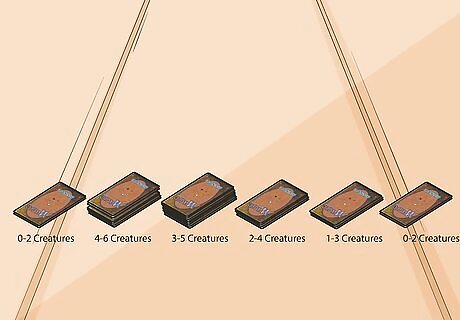
Evaluate your “mana curve”. The term “mana curve” refers to an imaginary bar graph (and the smooth curve it represents) that visually enumerates the “converted mana cost” of the cards in your deck. (The “converted mana cost” is the total number of mana required to cast each card, without respect to color.) If your “mana curve” is significantly slanted to the columns of 1 and 2, or alternatively, significantly slanted to high-number columns (5+), you may wish to review your “deck concept” and attempt to even out this disparity by replacing some of the cards you have chosen.

Select the “Land” cards that will complete your deck. Land is the most important part of your deck. if your land sucks, the deck is going to be at a disadvantage. That doesn’t mean only stock your deck with 4 Evolving wilds, 4 terra morphia expanses, 4 dual land, and 8 basic lands. Find a happy medium, and make sure that the mana ratio reflects the cards. In a reasonably sized deck you should have between 18-28 lands/mana sources. Now that you are ready to insert “Land” cards into your deck, you must again consider the colors that you chose earlier. MTG has two main types of “Land” cards, “Basic Land” cards and “Non-basic Land” cards. Unless a “Land” card reads “Basic Land” on it, it is a “Non-basic Land”. Each “Basic Land” provides one mana to your “mana pool” when you tap it of the color on the card (the “Wastes” card provides one colorless mana. Cards with a “Wastes” symbol in their “mana cost” require that the mana used be colorless). There are two factors to consider when adding “Land” cards to a deck that has more than one color. The first is the overall number of cards that contain each color, and the second is the total number of colored mana symbols of each type in the “mana costs” of the cards within your deck. These figures will assist you in choosing an appropriate number of “Land” cards that produce the various colors in your deck. A calculator may be useful. The quickest way to determine how many “Land” cards of each type you should add to a deck with two or more colors is to count the total number of colored mana symbols of one type in your deck, then divide that number by the total number of colored mana symbols in your deck. This will provide a ratio you can use to add “Land” cards of that color to the deck. (Example: Deck contains 17 “Plains” mana symbols in the “mana cost” of the cards in the deck, and 38 total colored mana symbols. 17/38 = 0.447. Using that ratio, 0.447*24 (or total desired “Land” cards) = 10.7, so roughly 11 of the 24 “Land” cards in your deck should produce White mana.) There are many “Land” cards in MTG that provide two or more colors of mana when they are tapped, or have a variety of other effects. Replacing a few “Basic Land” cards with these can have powerful effects on your deck, or simply help to make multi-color decks more reliable.
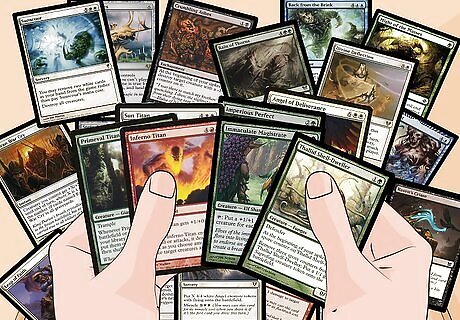
Pick out your creatures. Few creature-less decks can make it. Make sure you don't kill the economy of your deck though. If your creatures are weak, or cost too much Mana, you will die.
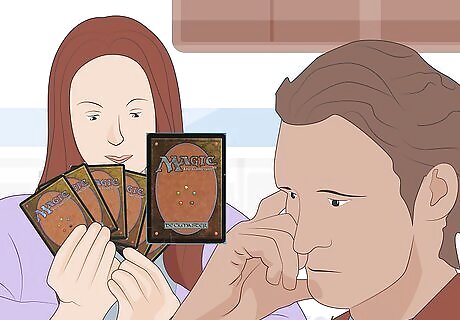
Don't forget the twist. Everyone wants to win, but the game gets stale and boring unless you can look in the eyes of your enemy and see the look of horror on his or her face as they realize you have killed them with 64 rat tokens.
Constructing Your Deck

Thread the “Land” cards into your deck (or shuffle thoroughly). The term “threading” land refers to the process of evenly spacing the “Land” cards throughout the deck (before shuffling your deck to start the game). This helps to ensure that the random element of drawing cards throughout the game will result in a proportionate number of “Land” cards to accompany your “Spells”.
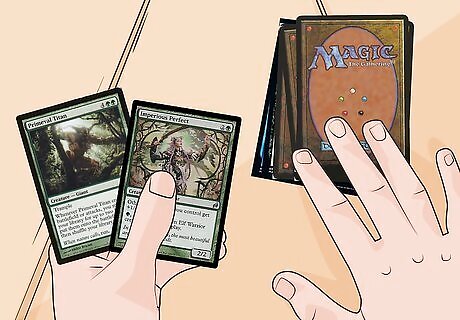
Test your deck by drawing seven cards. This action is known as a “test draw”, and will provide you with a sample of what type of opening hand you can expect while playing with your new deck. After drawing seven cards, look at the top two to five cards of your “Library” to see how this hypothetical game might play out, and what options you would have in the first few turns of the game. Due to the random nature of shuffling your deck and drawing seven cards, you should perform this step multiple times for optimal results.
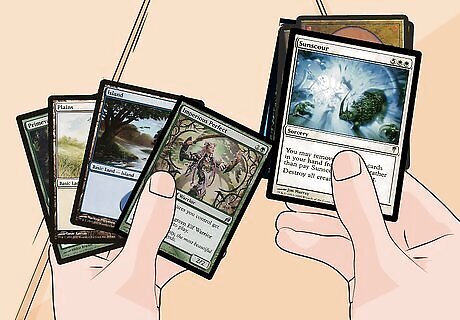
Adjust your deck based on your “test draws”. If you find that after several “test draws”, you are lacking adequate “Land” cards in order to play the “Spells” in your hand (or the correct colors of mana), you may wish to revisit the number of “Land” cards in your deck (or their associated colors). Other problems that can arise could be a lack of an adequate number of “Creature” cards, or an inability to play any “Spells” until the fourth turn or later of the hypothetical game you established with your “test draw”.

Research additional cards that may be valuable additions to your deck. Now that you’ve built your deck and compiled some information about the way that it will play in an actual game, you should research what other cards that you do not have in your collection that would support your “deck concept” and help you to finalize your deck, then consider acquiring those cards. In most game formats, you may have a maximum of four cards with the same name in your deck (the card name is the text printed at the top of the card. This rule does not include “Basic Lands”). If you find that you have less than four copies of a card that is central to your “deck concept”, you may wish to acquire and add the remaining missing copies of that card to cause your deck’s main features to function more consistently (keeping in mind the “mana curve” detailed earlier).
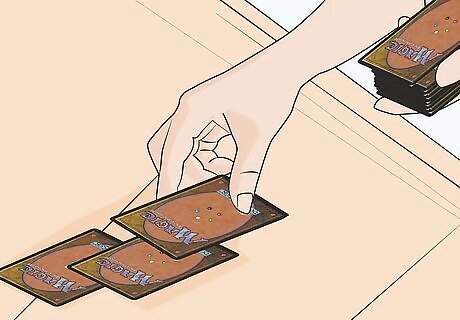
Select 15 additional cards to comprise your “side-board”. In most “Standard” and “Modern” format tournaments, a player is permitted to keep 15 cards that are not in their deck with them (outside the game). These 15 cards comprise a player’s “side-board”. Before any match, a player is allowed to replace any number of cards in their deck with cards from their “side-board”. This 15-card supplement can be used to add specific utilities or make other necessary adjustments to a player’s deck in-between matches. See How to Build a Sideboard.















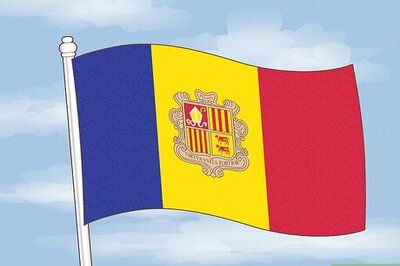


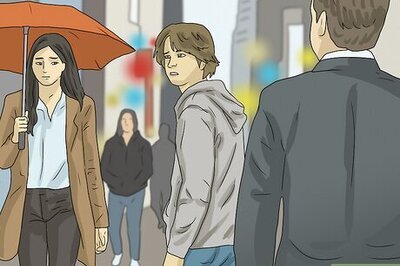
Comments
0 comment